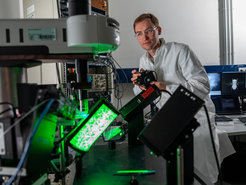Understanding how nerve cells do the math
Lukas Groschner receives Schilling Research Award of the German Neuroscience Society 2023
Human and animal brains are biological supercomputers made up of countless nerve cells. Individual cells constantly receive and send electrical signals and, in the process, perform calculations on them. Lukas Groschner of the Max Planck Institute for Biological Intelligence studies the fruit fly Drosophila melanogaster to understand how nerve cells perform these arithmetic calculations. His work links the fields of biophysics, neurobiology and behavioral biology. For his research, he has been awarded the Schilling Research Award of the Neuroscience Society 2023, endowed with € 20,000.

Nerve cells are constantly receiving electrical signals that need to be processed. To do this, the cells perform mathematical calculations, such as additions or multiplications. Then, they pass on the results as signals to other cells. Through the cooperation of many nerve cells, animals can process sensory inputs and perform learned behaviors. This is how they find their way around their environment, track down food, and escape from enemies.
In their latest publication, Lukas Groschner, project leader in the department of Alexander Borst, and his colleagues described how certain neurons in the visual system of the fruit fly multiply electrical signals. Multiplication is necessary for motion vision, but until recently, it could not be observed experimentally. The scientists succeeded in measuring it with the help of tiny electrodes. This methodological milestone enabled the researchers to decipher the biophysical processes involved in the multiplication of nerve signals.
The German Neuroscience Society now honors this work and Lukas Groschner's previous research on the computational operations in single neurons with the Schilling Research Award. For more information, please visit the website of the German Neuroscience Society.












